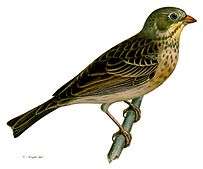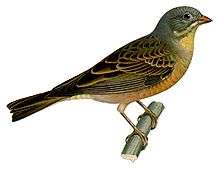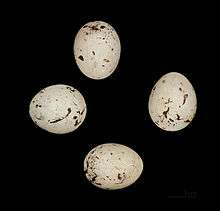Ortolan bunting
| Ortolan bunting | |
|---|---|
 | |
| Scientific classification | |
| Kingdom: | Animalia |
| Phylum: | Chordata |
| Class: | Aves |
| Order: | Passeriformes |
| Family: | Emberizidae |
| Genus: | Emberiza |
| Species: | E. hortulana |
| Binomial name | |
| Emberiza hortulana Linnaeus, 1758 | |
The ortolan, or ortolan bunting (Emberiza hortulana) is a bird in the bunting family Emberizidae, a passerine family now separated by most modern scholars from the finches, Fringillidae. The genus name Emberiza is from Old German Embritz, a bunting. The specific hortulana is from the Italian name, hortulane, for this bird.[2] The English Ortolan is derived from Middle French hortolan, "gardener".[3]
In September 2007, the French government announced its intent to enforce long ignored laws protecting the bird.[4][5]
Physical characteristics
The ortolan is 16 cm in length and weighs 20–25 grams (0.71–0.88 oz). In appearance and habits it much resembles its relative the yellowhammer, but lacks the bright colouring of that species; the ortolan's head, for instance, is greenish-grey, instead of a bright yellow. The song of the male ortolan resembles that of the yellowhammer.
Behaviour
Ortolan nests are placed on or near the ground.
Seeds are the natural diet, but beetles and other insects are taken when feeding their young.
Distribution and habitat
A native of most European countries and western Asia, its distribution throughout its breeding range seems to be very local, and for this no obvious reason can be assigned. It reaches as far north as Scandinavia and beyond the Arctic Circle, frequenting cornfields and their neighbourhoods. It is an uncommon vagrant in spring, and particularly autumn, to the British Isles.
Gastronomy
For centuries, a rite of passage for French gourmets was the eating of the Ortolan. These tiny birds—captured alive, force-fed, then drowned in Armagnac—were roasted whole and eaten that way, bones and all, while the diner draped his head with a linen napkin to preserve the precious aromas and, some believe, to hide from God.


The birds are caught with nets set during their autumn migratory flight to Africa. They are then kept in covered cages or boxes. This "artificial night" causes the birds to gorge themselves on grain (usually millet seed) until they double their bulk. "Roman Emperors stabbed out ortolans’ eyes in order to make the birds think it was night, making them eat even more". The birds are then thrown into a container of Armagnac which both drowns and marinates the birds.[7]
The bird is roasted for eight minutes and then plucked. The consumer then places the bird feet first into their mouth while holding onto the bird's head. The ortolan is then eaten whole, or without the head and the consumer spits out the larger bones. The traditional way French gourmands eat ortolans is to cover their heads and face with a large napkin or towel while consuming the bird. The purpose of the towel is debated. Some claim it is to retain the maximum aroma with the flavour as they consume the entire bird at once, others have stated "Tradition dictates that this is to shield – from God’s eyes – the shame of such a decadent and disgraceful act",[7] and others have suggested the towel hides the consumers spitting out bones.[8] This use of the towel was begun by a priest, a friend of Jean Anthelme Brillat-Savarin.[9]
At one time, the island of Cyprus formed a chief depot for the exportation of ortolans, which were pickled in spices and vinegar and packed in casks containing from 300 to 400 each. In the early 20th century, between 400 and 500 casks were annually exported from Cyprus.[10]
Noted meals
- In the 1944 novella Gigi and its adaptations, the title character is taught by her Aunt Alicia the proper way to eat ortolans.
- In 1975, food critic Craig Claiborne made a winning $300 bid in an auction for a dinner for two, courtesy of American Express, at any restaurant in the world that takes its credit card. Claiborne selected Chez Denis in Paris for a $4000 meal [11] (equivalent to $18,000 in 2015) that included a course of ortolans.
- In 1996, François Mitterrand's last meal included this specially prepared bird.[12]
- Anthony Bourdain describes the eating of ortolans in the opening to his 2010 book Medium Raw.[13]
Legal status

Ortolan hunting was banned in France in 1999, but the law was poorly enforced and it is thought that up to 50,000 ortolans were killed each year. According to France’s League for the Protection of Birds, France's ortolan population fell 30 per cent between 1997 and 2007.[14] In 2007, the French government vowed to strictly enforce some existing rules about banning the practice, with the maximum fine set at €6,000 (£4,800). Killing and cooking ortolans is banned across the EU. In 2007, the pressure from France's League for Protection of Birds and from the European Union resulted in the French government promising to enforce the EU directive protecting the ortolan.[15]
European Union member states prohibit:[16]
- deliberate killing or capture of these birds by any method;
- deliberate destruction of, or damage to, their nests and eggs or removal of their nests;
- taking their eggs in the wild and keeping these eggs;
- deliberate disturbance of these birds particularly during the period of breeding and rearing, insofar as this would have a significant negative effect on the birds;
- keeping birds, the hunting and capture of which is prohibited;
- sale, transport for sale, keeping for sale and the offering for sale of live or dead birds and of any readily recognizable parts or derivatives of these birds.
See also
References
- ↑ BirdLife International (2012). "Emberiza hortulana". IUCN Red List of Threatened Species. Version 2013.2. International Union for Conservation of Nature. Retrieved 26 November 2013.
- ↑ Jobling, James A. (2010). The Helm Dictionary of Scientific Bird Names. London, United Kingdom: Christopher Helm. pp. 145, 195. ISBN 978-1-4081-2501-4.
- ↑ "Ortolan". Oxford English Dictionary (3rd ed.). Oxford University Press. September 2005. (Subscription or UK public library membership required.)
- ↑ Roasted songbird banned in France from MSNBC.com
- ↑ Susan Bell (September 9, 2007). "France's songbird delicacy is outlawed". Sunday Telegraph. Retrieved 2008-02-21.
- ↑ "France Bans an Old Culinary Tradition". 30 June 1999. Retrieved 2011-04-11.
- 1 2 Wallop, H. (2014). "Why French chefs want us to eat this bird – head, bones, beak and all". The Telegraph. Retrieved March 16, 2015.
- ↑ "French chefs seek to put banned songbird called ortolan back on menu". ABC. 2014. Retrieved March 16, 2015.
- ↑ The Urban Hunt from The Stranger
- ↑
 Rines, George Edwin, ed. (1920). "Ortolan". Encyclopedia Americana.
Rines, George Edwin, ed. (1920). "Ortolan". Encyclopedia Americana. - ↑ Claiborne, Craig (November 14, 1975). "Just a Quiet Dinner for Two in Paris: 31 Dishes, Nine Wines, a $4,000 Check". The New York Times. Retrieved 2010-12-14.
- ↑ "François Mitterrand's Last Meal". NPR. February 18, 2006. Retrieved 2008-05-26.
- ↑ Bourdain, Anthony. Medium Raw. Harper Collins Press, 2010, pp. xi - xvi.
- ↑ Wallop, Harry. "Ortolans: could France's cruellest food be back on the menu?". The Telegraph. Telegraph Media Group. Ltd. Retrieved 12 July 2015.
- ↑ The songbirds slaughtered for a Frenchman's supper. Daily Mail. September 7, 2010.
- ↑ "Ortalan Bunting, Emberiza hortulana factsheet" (PDF). EU Wildlife and Sustainable Farming project. European Commission. 2009.
External links
| Wikimedia Commons has media related to Emberiza hortulana. |
-
 Newton, Alfred (1911). "Ortolan". Encyclopædia Britannica (11th ed.).
Newton, Alfred (1911). "Ortolan". Encyclopædia Britannica (11th ed.). -
 "Ortolan". New International Encyclopedia. 1905.
"Ortolan". New International Encyclopedia. 1905. - Ortolan Bunting (emberiza hortulana) from the website of the European Commission
- 343: Poultry Slam 2007, a November 2007 episode of This American Life with a segment about eating ortolan
- Oiseaux Photographs, text, map; (French)
- Ageing and sexing (PDF; 1.6 MB) by Javier Blasco-Zumeta and Gerd-Michael Heinze
